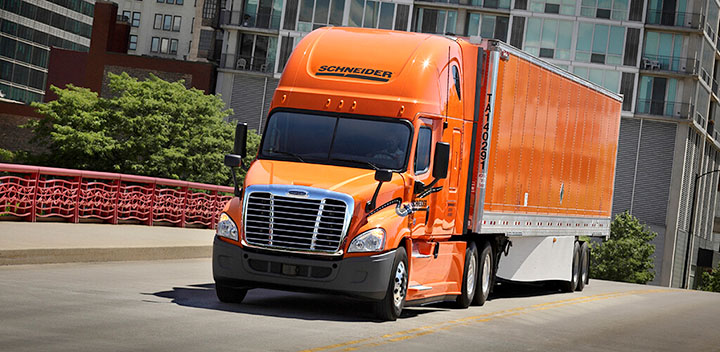GREEN BAY, Wisc. — Schneider National Inc. released results for the second quarter of 2020 in late July, reporting drops in both operating revenue and income compared to 2019. The company’s operating revenues for April-June of this year were $1 billion, down from $1.2 billion in 2019, and adjusted income from operations dropped to $63.6 million for 2020 compared to $83.8 million last year.
“During the second quarter, operating conditions varied across our diverse portfolio of services largely due to the differing effects of COVID-19,” said Mark Rourke, president and CEO of Schneider.
Enterprise income from operations for the second quarter of 2020 was $63.4 million, an increase of $14.2 million (29%) compared to the same quarter in 2019. Second quarter 2019 income from operations included a $34.6 million goodwill impairment charge related to the First to Final Mile (FTFM) service offering, which was shut down in August 2019. Adjusted income from operations was $63.6 million for the second quarter of 2020, a decrease of $20.2 million (24%) compared to the same quarter in 2019.
“Of our various segments, intermodal was most negatively impacted by the pandemic while the impact to truckload and logistics was proportionately less. Volumes improved as the quarter progressed, and our cost containment actions helped mitigate the earnings impact of the challenging market. By mid-May, we were able to pivot from sustaining our operations and return to advancing our strategic initiatives,” Rourke said. “I’m proud of the performance and adaptability of our associates and want to publicly thank our professional drivers who are on the front line and are vital to keeping goods moving throughout the country.”
Truckload revenues (excluding fuel surcharge) for the second quarter of 2020 were $451.1 million, a decrease of $83.8 million (16%) compared to the same quarter in 2019, primarily due to the shutdown of FTFM and lower volume and price. Truckload volume increased as the quarter progressed and ended June near prior year levels (adjusted for FTFM).
Truckload income from operations was $40.5 million in the second quarter of 2020, an increase of $32.6 million, compared to the same quarter in 2019 which included goodwill impairment of $34.6 million and operating losses of $13.1 million related to FTFM. Improved variable cost management in areas of driver recruiting, maintenance and fuel partially offset the impact of lower volume and price. Truckload segment operating ratio was 91% in the second quarter of 2020 compared to 98.5% in the second quarter of 2019. Adjusted for the effects of FTFM, second quarter 2019 operating ratio was 89%.
“In our truckload segment, we redeployed and leveraged resources across both our network and dedicated operations to meet the dynamic needs of our customers,” Rourke said.
Intermodal revenues (excluding fuel surcharge) for the second quarter of 2020 were $219 million, a decrease of $40.8 million (16%) compared to the same quarter in 2019. Network demand disruptions due to weak Asia import volumes combined with the prolonged shutdown of non-essential retail customers and lower revenue per order, resulted in decreased revenue compared to the same quarter a year ago. Shorter length of haul, driven by a decrease in transcontinental volume and an increase in Eastern volume, contributed to lower revenue per order. Schneider is actively addressing network balance.
Intermodal income from operations for the second quarter of 2020 was $11 million, a decrease of $19.5 million (64%) compared to the same quarter in 2019 primarily due to decreased revenues and higher rail costs. Intermodal operating ratio was 95% for the second quarter of 2020 compared to 88.2% in the second quarter of 2019.
“Our intermodal segment volume improved in May and June, however, was impacted by reduced Asia import activity and extended nonessential retail shutdowns which resulted in an unbalanced network,” Rourke noted.
Logistics revenues (excluding fuel surcharge) for the second quarter of 2020 were $230.9 million, an increase of $3.9 million (2%) compared to the same quarter in 2019, primarily due to increased volume.
Logistics income from operations for the second quarter of 2020 was $8.2 million, a decrease of $1 million (11%) compared to the same quarter in 2019 primarily due to lower net revenue per order. Logistics operating ratio was 96.4% in the second quarter of 2020, a sequential improvement of 180 basis points from the first quarter of 2020 due to improved net revenue per order early in the quarter and cost containment actions.
“In our logistics segment, operating ratio improved 180 basis points sequentially primarily due to improved net revenue early in the quarter,” Rourke said.
“Although uncertainty remains, we have been positioning the company for a second half 2020 freight market with increased demand and constrained supply. It is our current view that the most significant impact of the pandemic on our operations was borne in the second quarter,” he concluded.
The Trucker News Staff produces engaging content for not only TheTrucker.com, but also The Trucker Newspaper, which has been serving the trucking industry for more than 30 years. With a focus on drivers, the Trucker News Staff aims to provide relevant, objective content pertaining to the trucking segment of the transportation industry. The Trucker News Staff is based in Little Rock, Arkansas.















